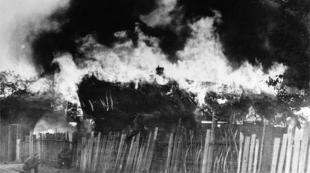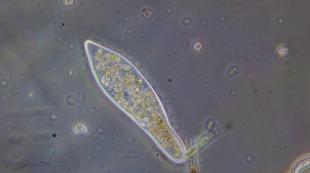Ammonia buffer system. buffer solutions. Classification of buffer solutions. The mechanism of their action. The mechanism of action of buffer solutions
Definition.
In laboratory practice, it is often necessary to work with solutions that have a certain pH value. Such solutions are called buffer solutions.
buffer solutions- solutions, the pH of which practically does not change when added to them large quantities acids and bases or when diluted.
Buffer solutions can be of four types:
1. Weak acid and its salt. For example, an acetate buffer solution of CH 3 COOH + CH 3 COONa (pH=4.7).
2. Weak base and its salt. For example, ammonia buffer solution NH 4 OH + NH 4 Cl (pH=9.2).
3. A solution of two acid salts. For example, phosphate buffer solution NaH 2 PO 4 + Na 2 HPO 4 (pH=8). In this case, the salt plays the role of a weak acid.
Amino acid and protein buffer solutions.
Mechanism of action.
The action of buffer solutions is based on the fact that buffer ions or molecules bind H + or OH ions of acids or alkalis introduced into them to form weak electrolytes. For example, if hydrochloric acid is added to an acetate buffer solution of CH 3 COOH + CH 3 COOH, then the following reaction will occur:
CH 3 COOHa + Hcl \u003d CH 3 COOH + NaCl
CH 3 COO - + H + = CH 3 COOH
CH 3 COO - ions, interacting with H + cations of hydrochloric acid, form molecules of acetic acid, H + does not accumulate in the solution, therefore their concentration practically does not change, and therefore the pH value of the solution does not change.
When an alkali (for example, NaOH) is added to an acetate buffer solution, the following reaction occurs:
CH 3 COOH + NaOH \u003d CH 3 COONa + H 2 O
CH 3 COOH + OH - \u003d CH 3 COO - + H 2 O
H + cations of acetic acid combine with OH - alkali ions, forming water. The acid concentration decreases. Instead of the consumed H + cations, as a result of the dissociation of acetic acid CH 3 COOH, H + cations reappear and their previous concentration is restored and the pH value of the solution does not change.
buffer capacity.
Any buffer solution practically maintains a constant pH only until a certain amount of acid or alkali is added, that is, it has a certain buffer capacity.
Buffer capacity - that limiting amount (mol) of a strong acid or alkali that can be added to 1 liter of a buffer solution so that its pH changes by no more than one.
Cooking.
Buffer properties are very weak if the concentration of one component is 10 times or more different from the concentration of another. Therefore, buffer solutions are often prepared by mixing solutions of equal concentrations of both components, or by adding an appropriate amount of a reagent to a solution of one component, leading to the formation of an equal concentration of the conjugated form.
To prepare an ammonia buffer mixture, mix 100 ml of a solution of NH 4 Cl with a mass fraction of 10% and 100 ml of a solution of NH 4 OH with a mass fraction of 10% and dilute the resulting mixture with distilled water to 1 liter.
Application.
Buffer solutions are widely used in chemical analysis, biochemical analysis to create and maintain a certain pH value of the medium during reactions.
For example, Ba 2+ ions are separated from Ca 2+ ions by precipitation with dichromate ions Cr 2 O 7 2- in the presence of an acetate buffer solution; in the determination of many metal cations using Trilon B, the complexometric method uses an ammonia buffer solution.
Buffer solutions ensure the constancy of biological fluids and tissues. The main buffer systems in the body are bicarbonate, hemoglobin, phosphate and protein. Moreover, the action of all buffer systems is interconnected. Hydrogen ions coming from outside or formed in the process of metabolism are bound by one of the components of the buffer systems. However, in some diseases, a change in the pH value of the blood may occur. The shift in the pH value of the blood to the acidic region from the normal value of pH 7.4 is called acidosis, to the alkaline region - alkalosis. Acidosis occurs in severe forms of diabetes mellitus, prolonged physical work and inflammatory processes. In severe renal or hepatic insufficiency, or in case of respiratory failure, alkalosis may occur.
biological fluids, tissues and organs.
This finds expression in fairly constant pH values of biological media (blood, saliva, gastric juice, etc.) and the body's ability to restore normal pH values when exposed to protoliths. System supporting protolytic homeostasis, includes not only physiological mechanisms (pulmonary and renal compensation), but also physicochemical ones: buffering action, ion exchange and diffusion.
Ensuring the constancy of the pH of the blood and other organs and tissues is one of the most important conditions for the normal existence of the body. This provision is achieved by the presence in the body of numerous regulatory systems, the most important of which are buffer systems. The latter play a major role in maintaining the COR in the body.
In addition, the material of this topic is necessary for the study of subsequent topics of the subject (potentiometry, properties of IUD solutions, etc.) and such disciplines as biochemistry, microbiology, histology, hygiene, physiology, in the practice of a doctor when assessing the type and severity of COR disorders.
buffer solutions called solutions that maintain their pH values unchanged when diluted or when a small amount of a strong acid or base is added. Protolytic buffer solutions are mixtures of electrolytes containing ions of the same name.
There are basically two types of protolytic buffer solutions:
Acid i.e. consisting of a weak acid and an excess of its conjugate base (salt formed by a strong base and an anion of this acid). For example: CH 3 COOH and CH 3 COOHa - acetate buffer
CH 3 COOH + H 2 O ↔ H 3 O + + CH 3 COO - excess conjugated
acid base
CH 3 COOHa → Na + + CH 3 COO -
Basic, i.e. consisting of a weak base and an excess of its conjugate acid (i.e., a salt formed by a strong acid and a cation of this base). For example: NH 4 OH and NH 4 Cl - ammonia buffer.
NH 3 + H 2 O ↔ OH - + NH 4 + excess conjugated
acid base
NH 4 Cl → Cl - + NH 4 +
The buffer system equation is calculated using the Henderson-Hasselbach formula:
pH \u003d pK + lg, pOH \u003d pK + lg,
where pK = -lg K D.
C - molar or equivalent concentration of electrolyte (C \u003d V N)
The mechanism of action of buffer solutions
Consider it on the example of acetate buffer: CH 3 COOH + CH 3 COOHa
The high concentration of acetate ions is due to the complete dissociation of a strong electrolyte - sodium acetate, and acetic acid in the presence of the anion of the same name exists in solution in a practically non-ionized form.
1. When a small amount of hydrochloric acid is added, H + ions bind to the conjugate base CH 3 COO - present in the solution into a weak electrolyte CH 3 COOH.
CH 3 COO‾ + H + ↔ CH 3 COOH (1)
Equation (1) shows that the strong acid HC1 is replaced by an equivalent amount of the weak acid CH 3 COOH. The amount of CH 3 COOH increases and, according to the law of dilution by W. Ostwald, the degree of dissociation decreases. As a result, the concentration of H + ions in the buffer increases, but very slightly. The pH is kept constant.
When adding acid to the buffer, the pH is determined by the formula:
pH = pK + lg
2. When a small amount of alkali is added to the buffer, it reacts with CH 3 COOH. Acetic acid molecules will react with hydroxide ions to form H 2 O and CH 3 COO ‾:
CH 3 COOH + OH ‾ ↔ CH 3 COO‾ + H 2 O (2)
As a result, the alkali is replaced by an equivalent amount of weakly basic salt CH 3 COONa. The amount of CH 3 COOH decreases and, according to the law of dilution by W. Ostwald, the degree of dissociation increases due to the potential acidity of the remaining undissociated molecules of CH 3 COOH. Consequently, the concentration of H + ions practically does not change. The pH remains constant.
When alkali is added, pH is determined by the formula:
pH = pK + lg
3. When diluting the buffer, the pH also does not change, because the dissociation constant and the ratio of components remain unchanged.
Thus, the pH of the buffer depends on: dissociation constants and concentration ratios of components. The larger these values, the higher the pH of the buffer. The pH of the buffer will be greatest at a ratio of components equal to one.
To quantitatively characterize the buffer, the concept is introduced buffer capacity.
Size: px
Start impression from page:
transcript
2 Main questions: 1. Buffer systems, composition and mechanism of their action 2. Acetate, phosphate, ammonia, hydrocarbonate, hemoglobin buffers 3. Calculation of pH buffer solutions. 4. Buffer capacity and factors affecting it 5. Importance of buffer systems for chemistry and biology, medicine and pharmacy
3 In the process of metabolism in our body, a lot of hydrochloric, pyruvic, lactic acids are released. But the pH is strictly preserved in the body. The constancy of the pH of biological media is maintained not only with the help of physiological mechanisms (pulmonary and renal compensation), but with the help of physicochemical buffering, ion exchange and diffusion. Maintaining the acid-base balance at a given level is ensured at the molecular level by the action of buffer systems.
4 Solutions that maintain a constant pH value when small amounts of strong acids and alkalis are added, as well as when diluted, are called protolytic buffer systems. The ability of some solutions to keep the concentration of hydrogen ions unchanged is called the buffering action, which is the main mechanism of protolytic homeostasis. Buffer solutions are mixtures of a weak base or weak acid and their salt. In buffer solutions, according to the theory of Bronsted Lowry, the main "acting" components are proton donor and acceptor.
5 Buffer solutions can be prepared in two ways: 1. Partial neutralization of a weak electrolyte with a strong electrolyte: CH 3 COOH (excess) + NaOH; NaOH (excess) + HCl 2. Mixing solutions of weak electrolytes with their salts (or two salts): CH 3 COOH and CH 3 COOHa; NH 3 and NH 4 Cl; NaH 2 RO 4 and Na 2 HPO 4
6 The reason for the emergence of a new quality of buffering action in solutions is the combination of several protolytic equilibria B (base) + H + HB + (resisting acid) HA (acid) H + + A - (resisting base) Conjugated acid-base pairs HB + /Vi HA/A - are called buffer systems, which are combined equilibrium processes of ionization and hydrolysis.
7 Thus, protolytic buffer systems consist of: two components. I. weak conjugate. acid base II. weak base is conjugated. acid One of the components binds H + strong acid, the other OH - strong alkali.
8 CLASSIFICATION OF BUFFER SYSTEMS I. Acid buffer systems. They are a mixture of a weak acid HA (proton donor) and its salt A - (proton acceptor). q acetate: CH 3 COOH + CH 3 COOHa CH CH 3 3 COOH COO q hydrocarbonate: Weak acid Conjugate base H 2 CO HCO 3 3
9 II. Basic buffer systems. They are a mixture of a weak base (proton acceptor) and its salt (proton donor). Ammonia buffer system: a mixture of a weak base NH 3 H 2 O (proton acceptor) and its strong electrolyte salt NH + 4 (proton donor). Buffer zoneprin 8.2-10.2 NH 4 NH OH + 4 Weak base Conjugate acid
10 III. Salt buffer systems. KH 2 PO 4 + K 2 HPO 4 intracellular NaH 2 PO 4 +Na 2 HPO 4 outside the cell Hydrophosphate buffer system (buffer action zone pH 6.2 8.2). It is a mixture of weak acid H 2 PO - 4 (proton donor) ieesolinro 2-4 (proton acceptor) H 2RO HPO Weak acid Conjugate base
11 IV. Amino acid and protein buffer systems. The buffering effect of these buffer systems begins to manifest itself when a certain amount of acid or alkali is added to them. A mixture of two forms of the protein is formed: a) a weak “protein-acid” + a salt of this weak acid b) a weak “protein-base” + a salt of this weak base
12 Calculation of the pH of buffer systems (Henderson-Hasselbach equation) Using the example of an acetate buffer solution, let us consider the calculation of buffer systems. CH COOH CH COONa Sodium acetate almost completely decomposes into ions: CH 3 COONa CH 3 COO - + H + 3 acetic acid dissociates only to a small extent: CH 3 COOH CH 3 COO - + H + Apply the law of mass action to the equation of dissociation of acetic acid:
13 In the presence of sodium acetate, the dissociation equilibrium of acetic acid is strongly shifted to the left in accordance with Le Chatelier's principle. Almost all of the acid in such a solution is in an undissociated form, and only a small amount of it dissociates, forming H + ions and providing an acidic environment for the solution. Therefore, the equilibrium concentration of the undissociated acid in this solution is practically equal to its total concentration, i.e. C (CH 3 COOH) equal. C (acids). The concentration of acetate ions in the buffer mixture is almost equal to the initial salt concentration: C(CH 3 COO -) C(salt).
14 In the equation of the dissociation constant of acetic acid, we substitute the total concentration of acid and salt, we get K d \u003d C C k you By taking the logarithm of this equation and reversing the signs, we get: salts, lgc \u003d lgk d C to you salt Since lg C (H +) \u003d pH, and lgkd \u003d pk acid, then + \u003d K d C C to you salt
15 ph \u003d pk to you lg C C to you salt or ph \u003d pk to you + lg C C acid salts This equation is called the Henderson-Hesselbach equation. This is the basic equation that is used to describe the acid-base balance in biological systems.
16 After a similar conclusion for the basic buffer systems: poh ph = = 14 pk basic pk + basic lg C lg C (salts) (bases) C C (salts) (bases) the nature of a weak electrolyte (pk (acid), pk (base), on the ratio of the concentrations of salt and acid (base) and temperature.
17 It should be noted that buffer systems effectively maintain the pH in the range: pk (acids) ±1 for acidic systems; 14 (pk(base)±1) for basic systems. The mechanism of action of buffer systems. 1. Dilution. When diluted with water, the concentrations of acid and salt decrease by the same number of times, but the ratio lg C (salt) / C (acid) does not change, so the pH of the buffer solution practically does not change. Also, the pk of an acid or pk of a base is independent of dilution. 2. Addition of acids and bases. When a small amount of a strong acid is added to the acetate buffer, ionine + (formed during its dissociation)
18 are bound by acetate ions contained in excess, with the formation of weakly dissociating CH 3 COOH molecules. The degree of dissociation of CH 3 COOH is small and the concentration of [H + ] practically does not change, the pH of the buffer solution will decrease, but only slightly. CH 3 COOH CH 3 COONa + HCl CH 3 COOH + NaCl x x x buffer pHfl pH = pk to you + lg C C salt to you x + x
19 When a small amount of NaOH is added, OH - ions are neutralized by the acid component of the buffer solution, with the formation of water molecules. CH 3 COOH + NaOH CH 3 COONa + H 2 O x x x CH 3 COONa buffer As a result, the added strong base is replaced by an equivalent amount of the weak conjugate base CH 3 COO -, which affects the reaction of the medium to a lesser extent. The pH of the buffer solution increases, but only slightly.
20 pH pH \u003d pk to you + lg C C salt to you + x x Example: compare the change in pH when passing 0.01 mol of hydrogen chloride through 1 l: Acetate buffer solution containing 0.1 mol / l of salt and acid ; v Distilled water C to you \u003d C salt After adding HCl: pH \u003d 4.75 + lg 0.1 0.01 0.1 + 0.01 pH \u003d 4.66; ΔрН = 4, = 0.09 pH units
21 v pH = 7 for distilled water. After passing 0.01 mol HCl ph = -lg 0.01 = 2; ΔрН = 7 2= 5 pH units The ability of a buffer solution to maintain pH as a strong acid or strong alkali is added at an approximately constant level is far from limiting and is limited by the value of the so-called buffer capacity.
22 BUFFER CAPACITY Buffer capacity (B) is the number of moles of strong acid or base equivalent that must be added to 1 liter of buffer solution to shift its pH by one. The buffer capacity of the system is determined in relation to the added acid (In acid) or base (alkali) (In basic) and is calculated by the formulas: In acid. \u003d C H (HA) ph - ph 0 V (HA), V (b.p.) H In the main. =, ph - ph V(B) V(b.p.) where V(HA), V(B) - volumes of added acid or alkali, l.; C n \u003d (HA), C n (B) molar concentrations of the equivalent, respectively, of acid and alkali; V(b.r.) - the volume of the initial buffer solution, l.; pH o, pH - pH values of the buffer solution before and after the addition of acid or alkali; pH-PH o - difference modulo. C(B)0
23 Buffer capacity in relation to acid (B acid) is determined by the concentration (number of equivalents) of the component with basic properties; the buffer capacity in relation to the base (In the main) is determined by the concentration (number of equivalents) of the component with acidic properties in the buffer solution.
24 Buffer capacity depends on the ratio of components and their concentration a) ratio of components salt acid 90 mmol 10 mmol = = = mmol HCl + 10 mmol HCl = = lg4 = 0.60 lg0.67 = -0.17 = 0.67 Buffer capacity is maximum at a ratio of components equal to one, while B main \u003d B acid, arn \u003d pk
25 b) concentration of components. The higher the concentration, the greater the buffer capacity. salt acid 20 mmol 50 = 1 = 1 20 mmol mmol HCl + 10 mmol HCl = 0.33 = 0, lg0.33= 0.48 lg0.67 = -0.17
26 The use of any buffer system is limited to a certain pH range: for acidic systems, pH = acid pK ±1; for basic systems pH =14 - (pk base ±1). CONCLUSION: The buffer capacity mainly depends on the ratio of the concentrations of the components and their absolute concentrations, and hence the dilution. Blood buffer systems liquid media The organism is supported by buffer systems: bicarbonate, hemoglobin, phosphate, protein. The action of all buffer systems in the body is interconnected, which provides biological fluids with a constant pH value. In humans and animals, buffer systems are found in the blood (plasma and erythrocytes), in cells and intercellular spaces of other tissues.
27 Blood buffer systems are represented by plasma buffer systems and erythrocyte buffer systems. Buffer systems of blood plasma Bicarbonate 35% Protein. 7% Phosphate 2% pH=7.4 44% The role of the latter is insignificant. They account for 44% of the buffer capacity of the blood. Buffer systems of erythrocytes pH=7.25 hemoglobin 35% hydrocarbonate 18% 56% Organic phosphate system 3% They account for 56% of the buffer capacity of the blood.
28 HYDROCARBONATE BUFFER SYSTEM The hydrocarbon buffer system accounts for 53% of the total buffer capacity of the blood (35% in plasma, 18% in erythrocytes). It is almost impossible to directly measure the concentration of carbonic acid in the blood. Therefore, instead of introducing the concentration of carbon dioxide into the Henderson-Hasselbach equation, this equation takes the following form: pH \u003d 6.1 + lg where pk \u003d lg (n 2 CO 3) \u003d 6.1
29 Practically in blood, the partial pressure of carbon dioxide CO 2 is measured. The concentration of CO 2 dissolved in plasma is calculated by multiplying by the solubility constant of CO 2. If expressed in kilopascals (kPa), then the constant is 0.23, if in mm. rt. Art. 0.03. Therefore, if P CO 2 is expressed in kPa, the equation takes the following form: pH \u003d 6.1 + lg The partial pressure of CO 2 in blood plasma is normally ~ 5.3 kPa (40 mmHg), which corresponds to CO 2 ~1.2 mmol/l.
30 The partial pressure of CO 2 in the blood plasma is normally ~ 5.3 kPa (40 mm Hg), which corresponds to the concentration of CO 2 ~ 1.2 mmol / l. The concentration of bicarbonate ions in the extracellular fluid at P CO 2 = 5.3 kPa is 24 mmol/L. The ratio in the extracellular fluid [HCO - 3]/[CO 2 ] (both values in mmol/l) is 20:1. According to the Henderson Hasselbach equation, this ratio corresponds to a blood plasma pH of 7.4: pH = 6.1 + lg24/1.2 = 6.1 + lg20 = 6.1 + 1.3 = 7.4 the reaction of the arterial blood plasma of healthy people corresponds to pH = 7.40.
31 Since there are more bicarbonates in the blood than, the buffer system of the blood is much larger for acids than for bases. This has a great biological significance, because More acids are produced during metabolism than bases. The concentration determines the reserve alkalinity of the blood. The alkaline reserve of blood is determined by the volume of carbon dioxide that is absorbed by 100 cm 3 of blood when it comes into contact with a gas mixture containing 5.5% CO 2 at a pressure of 40 mm Hg, which corresponds to the pressure of carbon dioxide in the lungs. Normally, the alkaline reserve of the blood is 50-65% (volume) CO2.
32 Ratio reduction :< 20 является причиной ацидоза. Различают газовый инегазовый ацидоз. Ацидоз газовый возникает при высокой концентрации СО 2 во вдыхаемом воздухе, заболевании органов дыхания (пневмония), угнетение дыхательного центра (анестетики, седативные препараты). Негазовый ацидоз возникает при накоплении нелетучих продуктов обмена, при ожогах и воспалительных процессах. Повышение соотношения [НСО 3- ]/ [СО 2 ]>20 leads to callalose.
33 Gas alkalosis Pneumonia, asthma Consequence of hyperventilation, including intensive ventilation of the lungs (decrease in CO 2 concentration). Non-gas alkalosis Loss of large amounts of HCl during vomiting Excretion of large amounts of H + when taking diuretics Introduction of large amounts of NaHCO 3 alkalis
34 Main clinical manifestations in acidosis and alkalosis Acidosis: Depression of the central nervous system, at pH below 7, depression reaches such a degree that one loses orientation; a person falls into a coma; Increased respiration to remove carbon dioxide, as an adaptive reaction Alkalosis: Overexcitation nervous system, which is accompanied by tetonic (convulsive) contractions; death may occur from tetonic contraction of the respiratory muscles
35 Correction of the acid-base state of the body. As an emergency aid for acidosis, an intravenous infusion of solutions of sodium bicarbonate is used, however, when it is administered, as a result of neutralization, CO 2 is released, which reduces the effectiveness of the agent. Trisamine, which binds excess protons, is deprived of this drawback: H 2 N-C (CH 2 OH) 3 + H + H 3 N + -C (CH 2 OH) 3. Sodium lactate is also used as a corrective agent for acidosis. To eliminate the phenomena of alkalosis, as one of the temporary measures, a solution of ascorbic acid is used.
36 It is possible to change the pH in other environments of the body, for example, in various parts of the digestive tract, especially in the stomach. With reduced acidity of gastric juice, dilute hydrochloric acid is prescribed, with increased various antacids: basic magnesium carbonate Mg (OH) 2 4 MgCO 3 H 2 O, magnesium oxide, calcium carbonate and calmagin (granules containing basic magnesium carbonate and sodium bicarbonate) . The basis of the pharmacological action of all these drugs is p-neutralization
37 Hemoglobin buffer system The hemoglobin buffer system is found only in erythrocytes. The mechanism of its action is associated with the addition and release of oxygen. In this regard, hemoglobin (Hb) has oxidized HHbO 2 and reduced HHb forms. HHv + O 2 HHvO 2 H + + HbO - 2 acid HHv H + + Hb acid conjugate base Mechanism of action based on reactions: conjugate base
38 HbO - 2+ H + HHbO 2 HHb + O 2 base HHbO 2 acid HHb + OH HbO H 2 O + OH Hb + H 2 O acid Hb + H + HHb base From the above schematic reactions it can be seen that the addition of a strong acid or strong alkali causes a protective reaction of the buffer system to maintain a constant pH value of the medium, which is explained by the binding of the added H + and OH and the formation of low-dissociating electrolytes.
39 The hemoglobin buffer system in the body functions effectively only in combination with the bicarbonate system. 1. Blood Plasma In the blood plasma due to the bicarbonate buffer system, a number of reactions occur, as a result of which carbon dioxide is formed. H 2 CO 3 + OH - H 2 O + HCO 3 - HCO 3 + H + H 2 CO 3 CO 2 H 2 O From blood plasma, CO 2 diffuses into erythrocytes, where the carbonic anhydrase enzyme catalyzes its interaction with water, forming carbonic acid. 2. Red blood cells H 2 O + CO 2 H 2 CO 3
40 In erythrocytes, the concentration of bicarbonate ions increases according to the scheme: Hb - + H 2 CO 3 HHb + HCO - 3 The resulting bicarbonate ions diffuse into the extracellular fluid. Venous blood returns to the lungs, hemoglobin reacts with oxygen and oxyhemoglobin is formed. 3. Lungs Oxyhemoglobin reacts with hydrocarbonate ions HHb + O 2 HHbO 2; HHvO 2 + HCO 3- HvO 2- + H 2 CO 3 H 2 CO 3 H 2 O + CO 2 The atmosphere is removed from the lungs by CO 2 due to pulmonary ventilation. This is basically the mechanism for maintaining the acid-base balance.
41 Protein buffer systems Protein buffer systems are ampholytic because they include α amino acids containing groups with acidic properties (COOH and NH + 3) and basic properties (COO and NH 2). The mechanism of action of such a buffer system can be represented as follows: acid buffer system a) H 3 N + R COOH + OH H 3 N + R COO + H 2 O protein acid b) H 3 N + R COO + H + H 3 N + R COOH protein salt of an acid (conjugate base)
42 main buffer system a) H 2 NR COO + H + H 3 N + R COO protein base b) H 3 N + R COO + OH H 2 NR COO + H 2 O base protein salt (conjugate acid) where R is a macromolecular residue squirrel. The role of blood plasma proteins in the homeostasis of hydrogen ions is very small. Phosphate buffer system The phosphate buffer system is found both in the blood and in the cell fluid of other tissues, especially in the kidneys.
43 In cells, it is represented by KH 2 PO 4 ik 2 HPO 4, in blood plasma and intercellular space - NaH 2 PO 4 and Na 2 HPO 4. The main role in the mechanism of action of this system is played by the H 2 PO - 4 ion: H 2 PO - 4 H + + H 2 PO 2-4 acid resist. base An increase in the concentration of H + leads to a shift of the reaction to the left, i.e. acid formation: HPO 2-4 H + + H 2 PO - 4 acid resist. base The blood phosphate buffer is closely related to the bicarbonate buffer. H 2 CO 3 + HPO 2-4 Na HSO 3 + H 2 RO - 4 vmochu
44 Ammonium buffer system Formed in the kidneys from glutamine under the influence of glutaminase in the reaction of oxidative deamination. NH 3 H + NH + 4 poh \u003d pk + lg NH 4 OH + R COOH R COONH 4
45 Use of BS in other areas Buffer solutions soils prevent an excessive increase in acidity or alkalinity, thus creating and maintaining conditions for plant life. To create an environment with a certain pH value in scientific research and many technological production processes. To prepare reference buffer solutions, which are used to set up devices for measuring active acidity. To maintain the constancy of the values of the electrochemical potential of the systems, BS are used, the operation of which is based on equilibrium.
Main questions: 1. Buffer systems, composition and mechanism of their action 2. Acetate, phosphate, ammonia, hydrocarbonate, hemoglobin buffers 3. Calculation of pH buffer solutions. 4. Buffer capacity and factors
BUFFER SYSTEMS. 1. Definition, classification, composition of the buffer system. 2. The mechanism of the buffer action. 3. Derivation of the pH formula for buffer systems. 4. Properties of buffer systems: impact on pH ratio
RUSSIAN NATIONAL RESEARCH MEDICAL UNIVERSITY General and bioorganic chemistry Course of lectures for students of medical, pediatric, Moscow and dental faculties Topic 6
LECTURES 910. Buffer systems. 1 Buffer systems are a collection of several substances in a solution that inform it buffer properties, i.e. the ability to resist a change in the active reaction of the environment (ph) when diluted,
Federal State Budgetary Educational Institution higher education VORONEZH STATE AGRARIAN UNIVERSITY NAMED AFTER EMPEROR PETER I Department of Chemistry Abstract report on inorganic
Topic of the lesson: BUFFER SOLUTIONS. The purpose of the lesson. Assimilate ideas about the composition, classification and mechanism of action of buffer systems. Learn to apply theoretical material to calculate pH and buffer
State budgetary educational institution of higher professional education "IRKUTSK STATE MEDICAL UNIVERSITY" of the Ministry of Health Russian Federation department
MINISTRY OF EDUCATION AND SCIENCE OF THE RUSSIAN FEDERATION NOVOSIBIRSK STATE UNIVERSITY SPECIALIZED EDUCATIONAL AND SCIENTIFIC CENTER Chemical equilibrium in solutions Novosibirsk 01 ACID-BASE
4. The concept of buffer solutions Definition of buffer systems and their classification Many reactions in solution proceed in the right direction only at a certain concentration of H + ions. Changing it to that
Example .. Construct a distribution diagram for a solution of phosphoric acid in the range of pH,0.0. Calculate the mole fractions of particles at pH =, 5, 9,. Equilibria occurring in a solution of phosphoric acid:
Federal State Budgetary Educational Institution of Higher Education VORONEZH STATE AGRARIAN UNIVERSITY NAMED AFTER EMPEROR PETER I Department of Chemistry Abstract report Biological
HYDROLYSIS General concepts Hydrolysis is an exchange reaction of the interaction of substances with water, leading to their decomposition. Hydrolysis can be inorganic and organic matter various classes.
2 3 INTRODUCTION High level knowledge, academic and social mobility, professionalism of specialists, readiness for self-education and self-improvement are the requirements of today. Concerning
MINISTRY OF HEALTH OF UKRAINE KHARKOV NATIONAL MEDICAL UNIVERSITY BUFFER SYSTEMS, THEIR BIOLOGICAL ROLE Guidelines for independent work 1st year students in discipline
Individual homework 5. HYDROGEN INDICATOR OF THE ENVIRONMENT. HYDROLYSIS OF SALTS THEORETICAL PART Electrolytes are substances that conduct electric current. The process of disintegration of a substance into ions under the action of a solvent
State Budgetary Educational Institution of Higher Professional Education MOSCOW STATE MEDICAL AND DENTAL UNIVERSITY of the Ministry of Health and Social Development
Seminar 1. Equilibrium in a homogeneous system, acid-base balance, use in titrimetry (author Ph.D. Monogarova O.V.). Analytical chemistry is the science of determining the chemical composition of substances
Lesson 5 HYDROGEN INDICATOR OF THE ENVIRONMENT. HYDROLYSIS OF SALTS Topic 1. Introductory control on the topic “Hydrogen index of the environment. Salt hydrolysis. 2. Seminar on the topic “Exchange reactions of electrolytes. Hydrogen
Blood buffer systems (from the English buffer, buff to soften the blow) are physiological systems and mechanisms that provide acid-base. 43765414836 Buffer systems, buffer solutions, buffer mixtures, systems,
LESSON 5 HYDROGEN INDICATOR OF THE ENVIRONMENT. HYDROLYSIS OF SALTS THEORETICAL PART Electrolytes are substances that conduct electric current. The process of disintegration of a substance into ions under the action of a solvent is called electrolytic
General Chemistry Student: Group: Work submission date: Purpose of work: Laboratory work 8 SOLUTIONS OF ELECTROLYTES Experience 1. The dependence of the electrical conductivity of solutions on the degree of dissociation of electrolytes Basic concepts:
MINISTRY OF HEALTH OF UKRAINE ZAPORIZHIA STATE MEDICAL UNIVERSITY DEPARTMENT OF PHYSICAL AND COLLOID CHEMISTRY
3 Electrolyte solutions Liquid solutions are divided into electrolyte solutions capable of conducting electric current, and non-electrolyte solutions, which are not electrically conductive. dissolved in non-electrolytes
Lecture 6 Acid-base equilibrium 1 Lecture plan 1. General properties of chemical equilibrium. 2. Electrolytic dissociation. Acids and bases according to Arrhenius. 3. Acidity of solutions. ph. Constants
Hydrolysis. Solubility product Topic 11 Reaction conditions between electrolytes Reactions in electrolyte solutions are reactions between ions Necessary condition reactions in solutions
Lecture 5 Protolytic equilibria in salt solutions (hydrolysis). buffer solutions. Equilibrium precipitate solution. Solubility product. PROTOLYTIC EQUILIBRIA IN SOLUTIONS OF SALT HYDROLYSIS interaction
What is ACID and BASE? ACID BASE EQUILIBRIUM Life is not a struggle against sin, not against the power of money, but against hydrogen ions Arrhenius, 1894 Bronsted-Lowry, 1923 Lewis, 1923
1. Theoretical basis method Lecture 2 Acid-base method The method is based on the neutralization reaction: H + + OH - H 2 O The method is used for the quantitative determination of acids and alkalis, as well as
Tasks for the exam in the discipline "General and inorganic chemistry" Ways of expressing the concentration of solutions. Acid-base titration. 1. In medical practice, a 0.9% NaCl solution is often used
RUSSIAN ECONOMIC UNIVERSITY named after G. V. PLEKHANOV Inorganic chemistry TOPIC: Electrolytic dissociation
1. Associate Professor of the Department of General and Inorganic Chemistry, National University of Science and Technology MISIS, Candidate of Chemical Sciences Marina Norairovna Ter-Hakopyan Chemical substance on the
18. Ionic reactions in solutions Electrolytic dissociation. Electrolytic dissociation is the breakdown of molecules in solution to form positively and negatively charged ions. The extent of decay depends
1. What is the charge of the nucleus of a carbon atom? 1) 0 2) +6 3) +12 4) -1 2. What do atoms 12 6C and 11 6C have in common? 1) Mass number 2) Number of protons 3) Number of neutrons 4) Radioactive properties
TASKS OF THE I (SELECTING) CORRESPONDENCE STAGE OF THE OLYMPIAD “YOUNG TALENTS OF PRIKAMIE. CHEMISTRY» 2008/2009 ACADEMIC YEAR It is necessary to answer the tasks in the answer file! In tasks 1-19, you must choose one or more
Theoretical foundations for the course "Structural Biochemistry" Lecturer Svetlana Bobkova, Doctor of Chemistry Topic: The structure of water. Physical properties water. dissociation of water. Ionic product of water.
Solutions (3) Equilibria in electrolyte solutions. pH and PR Lecture of the course "General and Inorganic Chemistry" for 11th grades of the SASC Acid-base equilibria in solutions According to Arrhenius: An acid is called an electrolyte,
Inorganic chemistry Purpose of work: Student: Group: Date of completion of work: Laboratory work SOLUTIONS OF ELECTROLYTES Experience 1. Electrical conductivity of solutions of strong and weak electrolytes Basic
SECTION II. ANALYTICAL CHEMISTRY Problem 1 (author P.V. Chulkin) 1. To simplify the solution, we express the composition of ammophos in terms of one parameter a: a(nh) 2 HPO (1 a)(nh)H 2 PO. The molar mass is M = 132a 115(1 a)
Solution of option 2 1. The electronic configuration of the anion O 2 (1s 2 2s 2 2p 6) is cations Na, Mg 2. 2. Molar mass of a simple substance Simple substance silicon Si. M = ρ V m = 2.33 12.1 = 28 g/mol. 3.
Hydrolysis of salts The work was performed by the Teacher of the highest category Timofeeva V.B. What is hydrolysis Hydrolysis is the process of the exchange interaction of complex substances with water Hydrolysis The interaction of salt with water, as a result
PROPERTIES OF SOLUTIONS Solutions are homogeneous (homogeneous) systems consisting of two or more components (components), the amounts of which can vary over a wide range. The solution consists of dissolved
Achinovich Olga Vladimirovna The doctrine of solutions Solutions are Solvent is Solute - Example: Water is a solvent if you dissolve a solid (glucose) or gas (CO 2). - And if
Federal Agency for Education Novgorod State University named after Yaroslav the Wise Department of Chemistry and Ecology Buffer s Guidelines for laboratory work Veliky Novgorod 2006
Negrebetsky 2008 2010 Lecture 5 Processes in solutions. Protolytic equilibria MOST IMPORTANT CONCEPTS Processes in solutions 5.1 Negrebetsky 2008 2010 1. Equilibria in aqueous solutions. Hydration of ions. Polarity
LECTURE 5 Lecture plan:. Protolytic equilibria in salt solutions (hydrolysis of salts).. Group reagent for the third analytical group and its mechanism of action.. Group reagent for the second analytical group
Issues of differential test in medical chemistry for students of medical and dental faculties 1. Acid-base equilibrium and complex formation in biological solutions. 1. Biogenic
Solution of option 1 1. The electronic configuration of the Al 3+ cation (1s 2 2s 2 2p 6) is the anions F, O 2. 2. The molar mass of a simple substance The simple substance is gold Au. 3. ClCH 2 CH 2 CH 2 CH 2 CH 2 CH 3;
1 Theory. Ion-molecular equations of ion exchange reactions Ion exchange reactions are reactions between electrolyte solutions, as a result of which they exchange their ions. Ionic reactions
Ministry of Health of the Republic of Moldova State University Medicine and Pharmacy Nicolae Testemitanu Faculty of Pharmacy Department general chemistry G. V. BUDU, S. V. MELNYK ANALYTICAL
FEDERAL AGENCY FOR EDUCATION State Educational Institution of Higher Professional Education "TOMSK POLYTECHNICAL UNIVERSITY" APPROVED by Dean XTF V.M._Pogrebenkov 2007
Fundamentals of the theory of electrolytic dissociation Michael Faraday 22.IX.1791 25.VIII. 1867 English physicist and chemist. In the first half of the 19th century introduced the concept of electrolytes and non-electrolytes. Substances
1. The main properties are exhibited by the external oxide of the element: 1) sulfur 2) nitrogen 3) barium 4) carbon 2. Which of the formulas corresponds to the expression of the degree of dissociation of electrolytes: =
1 MODULE 1 GENERAL THEORETICAL FOUNDATIONS OF ANALYTICAL CHEMISTRY. QUALITATIVE ANALYSIS THEME: ACID-BASE EQUILIBRIUM AND THEIR ROLE IN ANALYTICAL CHEMISTRY (IN ANALYTICS). BUFFER SYSTEMS LECTURE 5 OBJECTIVE: TO FORM
1. Which of the following elements is the most typical non-metal? 1) Oxygen 2) Sulfur 3) Selenium 4) Tellurium 2. Which of the following elements has the highest electronegativity? 1) Sodium
Ministry of Education of the Russian Federation East Siberian State Technological University Comprehensive test tasks in general and inorganic chemistry Methodical development for self
1 Lecture 14 Ionic reactions Chemical reactions in electrolyte solutions are reduced to the exchange of ions. These reactions are characterized by very high rates. In the process of ion exchange reactions, the oxidation states
1 LECTURE Lecture plan: 1. Basic principles of the theory of electrolyte solutions. General (analytical) concentration and activity of ions in a solution, their relationship. The rate of a chemical reaction and chemical equilibrium.
STATE INSTITUTION OF HIGHER PROFESSIONAL EDUCATION "BELARUSIAN-RUSSIAN UNIVERSITY" Department "Metal Technologies" CHEMISTRY Guidelines to practical classes for students
LECTURE 3 Lecture plan: 1. Behavior of strong and weak monobasic acids in aqueous solutions. 2. Behavior of strong and weak single acid bases in aqueous solutions. 3. Behavior of strong and weak polybasic
Lecture 14 Exchange reactions in electrolyte solutions. Solubility product. dissociation of water. Salt hydrolysis Basic concepts: ion-exchange reactions, ion-molecular equations, solubility product
SOLUTIONS of the problems of the Olympiad "FUTURE KUZBASS" in chemistry 1. Carry out transformations: Mg MgO MgSO 4 Mg (OH) 2 Mg (OH) Cl MgCl 2 Li Li 2 O LiOH LiH 2 PO 4 Li 2 HPO 4 Li 3 PO 4 La La 2 O 3 La (OH) 2 NO 3 La (OH) 3
1 LECTURE 5 CLINICAL PATHOPHYSIOLOGY ACID-BASE STATE DISORDERS CONTENTS 1. INTRODUCTION 2. GENERAL INFORMATION ABOUT acid-base balance 3. THE SIGNIFICANCE OF CONSTANT acid-base balance for the body 4. CONSEQUENCES OF A PH+ SHIFT
CHEMISTRY. GENERAL AND INORGANIC CHEMISTRY. SALT HYDROLYSIS SALT HYDROLYSIS
Hydrogen indicator ph Indicators Essence of hydrolysis Types of salts Algorithm for compiling equations of hydrolysis of salts Hydrolysis of salts of various types Methods for suppressing and enhancing hydrolysis Solution of tests B4 Hydrogen
1. Give examples of the use of complexation reactions in the acid-base analysis method. Write reaction equations. Acid-base complexation reactions are used
Eye stage. Grade 11. Solutions. Task 1. A mixture of three gases A, B, C has a hydrogen density of 14. A portion of this mixture weighing 168 g was passed through an excess of a solution of bromine in an inert solvent
TITRATION CURVE - a graph of the dependence of a system parameter related to the concentration of a titratable substance, titrant or reaction product, on the degree of progress of the titration process (for example, on the amount
Collection of tasks in chemistry for the 9th medical class compiled by Gromchenko I.A. Moscow Education Center 109 2012 Mass fraction of the dissolved substance. 1. 250 g of solution contains 50 g of sodium chloride. Determine
Classify its composition and nature of the components.
Specify the range of pH values within which this system has a buffer capacity.
Write reaction equations reflecting the mechanism of its action (ionic form).
explain why the ammonia buffer system is not part of the blood
1. Composition and nature of the components:
A) NH 4 OH (NH 3 x H 2 O) - ammonium hydroxide, weak electrolyte
B) NH 4 C1 - salt, ammonium chloride, strong electrolyte.
Ammonium hydroxide is a weak electrolyte; in solution, it partially dissociates into ions:
NH 4 OH<=>NH 4 + + OH-
When ammonium chloride is added to an ammonium hydroxide solution, the salt as a strong electrolyte almost completely dissociates into ions:
NH 4 C1 > NH 4 + + C1-
and suppresses the dissociation of the base, the equilibrium of which is shifted towards the reverse reaction.
- The range of pH values within which the system under consideration has a buffer capacity is calculated by the formula:
where Kv is the dissociation constant NH 4 OH \u003d 1.8 * 10 -5, C 0 is the base concentration, Cs is the salt concentration.
pH=14-4.74+log(C0/Cc)=9.26+log(C0/Cc). Depending on the C 0 /Cc ratio, the range of pH values is 8.26-10.26.
- The ability of the ammonia buffer to maintain a practically constant pH value of the solution is based on the fact that the components included in them bind the H+ and OH- ions introduced into the solution or formed as a result of the reaction taking place in this solution. When a strong acid is added to an ammonia buffer mixture, H + ions will bind molecules or ammonium hydroxide, and not increase the concentration of H + ions and reduce the pH of the solution:
NH 4 OH + H + \u003d NH 4 + + H 2 O
When alkali is added, OH ions - will bind NH 4 + ions, thus forming a slightly dissociated compound, and not increase the pH of the solution:
NH 4 + +OH - \u003d NH 4 OH
- The ammonium buffer system is not included in the TOP RT blood composition, since the range of pH values within which it will have a buffer capacity is in the alkaline region (pH greater than 8). Normal plasma pH is 7.40 ± 0.05, i.e. below the buffering region.
1. 3)Write reaction scheme of interaction of ethanal with methylamine.
Describe the mechanism of this reaction.
Justify the role of an acid catalyst.
explain the possibility of the reaction of hydrolysis of the resulting imine in an acidic and alkaline environment.

2. The mechanism of this reaction is nucleophilic addition followed by elimination of a water molecule

3. The role of the acid catalyst - protonation at stage a)
4. In the presence of dilute acids, imines are hydrolyzed with water to form carbonyl compounds and amines, this reaction is the reverse of the imine synthesis reaction:

Hydrolysis does not occur in the presence of alkali.
Ticket 4.
Thermodynamic system (TM) - this is any real object isolated from the environment in order to study the processes of exchange of matter and energy between its constituent parts, as well as between it and environment using thermodynamic methods
Classification of thermodynamic systems
3. open exchange both matter and energy with the OS (an organism, an open vessel with boiling water)
4. Closed-exchanges with the OS only energy in the form of heat or work (gas in a closed balloon)
5. Isolated- do not exchange either content or energy. There are no absolutely isolated in nature.
By the presence of an interface inside the vehicle
1. Homogeneous- there is no interface, all components are in the water phase, all physical and chemical properties are the same in any part of the volume (mixture of gases)
2. Heterogeneous- contains the interface, the separating parts of the system (phases) are different in St. you (blood)
Parameters-values that determine the state of the vehicle
Where possible direct measurement
Basic parameters - parameters that can be measured using appropriate instruments (m, V, C, density, volume)
State functions - internal energy E(U); enthalpy (H); entropy (S); Gibbs energy (G); free energy or Helmholtz energy
You can define the change in the values of the state function
∆X(X 2 -X 1), WHERE X-U, H, S, G, H
Thermodynamic state-set of values of a certain number of physical. quantities characterizing all the physical and chemical properties of the system
Types of states:
Non-equilibrium - the parameters change spontaneously (a glass of hot water)
Equilibrium - parameters do not change without external influences
Stationary \u003d constancy of parameters due to external parameters (inherent in living organisms)
Process- the transition of the system from one state i to another, accompanied by changes in thermodynamic parameters.
Classification-
by the constancy of the parameters:
A) isochoric (v=const)
B) Isobaric (pressure - const)
C)isothermal(temperature=const)
By the sign of the thermal effect: exothermic and endothermic
By energy consumption: spontaneous, non-spontaneous
According to the character of the flow:-reversible - flow in the forward and reverse directions through the same stages, without changes in the environment. environment.
Irreversible - all processes cannot proceed in the forward and reverse directions through 1 and the same stages.
Buffer action mechanism (on the example of ammonia buffer)
We will consider the mechanism of action of the buffer system using the example of an ammonia buffer system: NH 4 OH (NH 3 x H 2 O) + NH 4 C1.
Ammonium hydroxide is a weak electrolyte; in solution, it partially dissociates into ions:
NH 4 OH<=>NH 4 + + OH -
When ammonium chloride is added to an ammonium hydroxide solution, the salt as a strong electrolyte almost completely dissociates into NH 4 C1 > NH 4 + + C1 - ions and suppresses the dissociation of the base, the equilibrium of which is shifted towards the reverse reaction. Therefore, C (NH 4 OH)? C (base); and C (NH 4 +)? C (salt).
If in a buffer solution C (NH 4 OH) \u003d C (NH 4 C1), then pH \u003d 14 - pKosn. \u003d 14 + lg 1.8.10-5 \u003d 9.25.
The ability of buffer mixtures to maintain a practically constant pH value of the solution is based on the fact that the components included in them bind the H+ and OH- ions introduced into the solution or formed as a result of the reaction taking place in this solution. When a strong acid is added to an ammonia buffer mixture, H+ ions will be bound by ammonia or ammonium hydroxide molecules, rather than increase the concentration of H+ ions and decrease the pH of the solution.
When alkali is added, OH ions - will bind NH 4 + ions, thus forming a low-dissociated compound, and not increase the pH of the solution.
The buffer action stops as soon as one of the components of the buffer solution (the conjugate base or the conjugate acid) is completely consumed.
To quantify the ability of a buffer solution to resist the influence of strong acids and bases, a quantity called buffer capacity is used. As the concentration of the buffer solution increases, its ability to resist pH changes when acids or alkalis are added increases.
The property of solutions to maintain the pH value within certain limits when adding small amounts of acid or alkali is called buffering action. Solutions that have a buffering effect are called buffer mixtures.
For titration case: oxalic acid and potassium hydroxide, draw titration curve, indicate titration case, titration step, equivalence point, indicators used
Titration jump: pH = 4-10. The maximum error in % is less than 0.4.
Indicators - thymolphthalein, phenolphthalein.
Restorer what elements periodic system elements can be reducing agents and why?
A reducing agent is a substance that donates electrons during a reaction, i.e. oxidized.
Reducing agents can be neutral atoms, negatively charged non-metal ions, positively charged metal ions in the lowest oxidation state, complex ions and molecules containing atoms in an intermediate oxidation state.
neutral atoms. Typical reducing agents are atoms that have 1 to 3 electrons in their outer energy level. This group of reducing agents includes metals, i.e. s-, d- and f-elements. Reducing properties are also exhibited by non-metals, such as hydrogen and carbon. In chemical reactions, they donate electrons.
Strong reducing agents are atoms with a low ionization potential. These include the atoms of the elements of the first two main subgroups of the periodic system of elements of D.I. Mendeleev (alkali and alkaline earth metals), as well as Al, Fe, etc.
In the main subgroups of the periodic system, the reducing power of neutral atoms increases with increasing atomic radius. So, for example, in the series Li - Fr, the weaker reducing agent will be Li, and the strongest - Fr, which is generally the strongest reducing agent of all elements of the periodic system.
Negatively charged non-metal ions. Negatively charged ions are formed by the addition of one or more electrons to a neutral non-metal atom:
So, for example, neutral atoms of sulfur, iodine, having 6 and 7 electrons at the outer levels, can attach 2 and 1 electrons, respectively, and turn into negatively charged ions.
Negatively charged ions are strong reducing agents, since under appropriate conditions they can donate not only weakly retained excess electrons, but also electrons from their external level. At the same time, the more active the non-metal is as an oxidizing agent, the weaker its reducing ability is in the negative ion state. Conversely, the less active a non-metal is as an oxidizing agent, the more active it is in the state of a negative ion as a reducing agent.
The reducing ability of negatively charged ions with the same charge value increases with increasing atomic radius. Therefore, for example, in the group of halogens, the iodine ion has a greater reducing ability than bromine and chlorine ions, and fluorine does not show any reducing properties at all.
Positively charged metal ions in the lowest oxidation state. Metal ions in the lowest oxidation state are formed from neutral atoms as a result of the return of only part of the electrons from the outer shell. So, for example, the atoms of tin, chromium, iron, copper and cerium, interacting with other substances, can initially give the minimum number of electrons.
Metal ions in the lowest oxidation state can exhibit reducing properties if they can have states with a higher oxidation state.
In the OVR equation, arrange the coefficients using the electronic balance method. Specify the oxidizing agent and reducing agent.
K 2 Cr 2 O 7 + 6FeSO 4 + 7H 2 SO 4 = K 2 SO 4 + Cr 2 (SO 4) 3 + 3Fe 2 (SO 4) 3 + 7H 2 O
1 Cr 2 +6 +3e x 2 Cr 2 +3 oxidizer
6 Fe +2 - 1e Fe +3 reducing agent
2KMnO 4 + 5H 2 S + 3H 2 SO 4 = K 2 SO 4 + 2MnSO4 + 5S + 8H 2 O
2 Mn +7 + 5е Mn +2 oxidant
5 S -2 - 2e S 0 reducing agent









